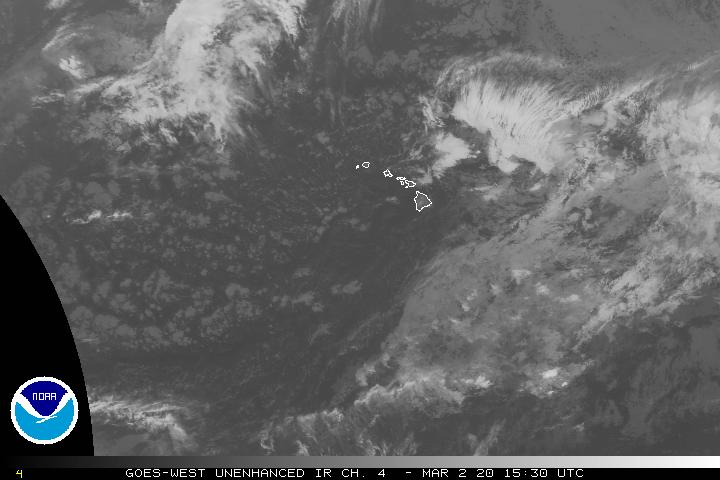Air Temperatures – The following high temperatures (F) were recorded across the state of Hawaii Thursday…along with the low temperatures Thursday:
74 – 67 Lihue, Kauai
83 – 73 Honolulu, Oahu
81 – 72 Molokai AP
84 – 71 Kahului AP, Maui
85 – 77 Kailua Kona
85 – 72 Hilo AP, Hawaii
Here are the latest 24-hour precipitation totals (inches) for each of the islands Thursday evening:
1.42 Kalaheo, Kauai
0.20 Maunawili, Oahu
3.01 Molokai
0.03 Lanai
0.00 Kahoolawe
1.40 Kahakuloa, Maui
0.85 Kawainui Stream, Big Island
The following numbers represent the strongest wind gusts (mph) Thursday evening:
14 Mana, Kauai
28 Waianae Harbor, Oahu
23 Molokai
27 Lanai
29 Kahoolawe
33 Kahului AP, Maui
35 Puu Mali, Big Island
Hawaii’s Mountains – Here’s a link to the live webcam on the summit of our tallest mountain Mauna Kea (nearly 13,800 feet high) on the Big Island of Hawaii. Here’s the webcam for the Haleakala Crater on Maui. These webcams are available during the daylight hours here in the islands, and at night whenever there’s a big moon shining down. Also, at night you will be able to see the stars — and the sunrise and sunset too — depending upon weather conditions.
Aloha Paragraphs

The tail-end of a cold front is over the eastern islands

A multi-layered cloud plume…remains over Kauai and Oahu

Partly to mostly cloudy skies over the islands

Showers locally – Looping image
~~~ Hawaii Weather Narrative ~~~
Flash Flood Watch…Niihau, Kauai, and Oahu
Broad Brush Overview: The persistent band of deep moisture continues to move over the islands, as an upper level trough of low pressure to the northwest of the state, slowly swings through the area over the next 2-days. The overlying atmosphere will become more unstable as the trough passes through the state, with increasing shower activity. The greatest rainfall amounts should fall over Kauai and Oahu, with periods of moderate to heavy rainfall expected to elevate the risk of flash flooding through tonight. This rainfall enhancing upper trough will pass through the islands on Saturday…bringing a welcome drying trend Sunday and Monday.
Details: This unusually long lasting deep tropical moisture remains parked over the islands, as an upper level trough northwest of Kauai slowly migrates in our direction through Saturday. The sub-tropical jet stream also lingers northwest of the Kauai, producing extensive high and middle level clouds, and light to moderate showers across Kauai and Oahu. The coverage and intensity of the rainfall will increase over the next 24 hours, as the dynamics with the trough move closer to the western islands. Deep low level moisture, and moderate atmospheric instability will likely produce periods of heavy rain, increasing the threat of flash flooding over Kauai County and Oahu through tonight.
The American (GFS) and European (ECMWF) models both remain in good agreement with this larger scale wet weather pattern over Hawaii. Consistency between both models and model runs means that there’s good confidence in this moderate to heavy rainfall threat. As the trough of low pressure approaches the state from the west Friday, it begins to weaken and lift northward. The southern end of the trough axis should pass through Kauai on Saturday morning, Oahu by Saturday afternoon and Maui County by Saturday night. Shower activity will diminish rapidly after the weakening trough axis passes across each island.
Looking Ahead: Meanwhile, as we get into the weekend time frame, a strong high pressure system builds across the Central Pacific. Moderate trade winds associated with this high will push a remnant frontal cloud band across the islands on Monday. Shower activity with this shallow cloud band will be minimal. Overall we should see drier air moving into the western half of the state with enough moisture lingering over Maui and Hawaii Counties for enhanced windward showers into the first half of next week. It looks like the leeward beaches will finally beginning having more typical spring weather conditions…with likely sunshine galore for a change!
Here’s a wind profile of the Pacific Ocean – Closer view of the islands / Here’s the vog forecast animation / Here’s the latest weather map
Marine environment details: Winds and seas are expected to remain below Small Craft Advisory (SCA) levels through the weekend. Trade winds could pick up early next week, which could bring SCA level winds to some of the typically windier locations.
No significant swells are expected through the weekend. Surf along north facing shores will continue to slowly decrease through the end of the week, with another north swell expected to arrive late this weekend or early next week, peaking below advisory levels. A southerly swell affecting the area should start lowering Friday. Surf along east facing shores should remain small through the weekend, however, as trade winds increase early next week…rough surf will be possible along the windward shores shores.

World-wide Tropical Cyclone activity
Here’s the latest Pacific Disaster Center (PDC) Weather Wall Presentation…covering tropical disturbances being referred to as Invest 96W and Invest 97W both in the western Pacific Ocean
![]()
>>> Atlantic Ocean:
>>> Caribbean Sea:
>>> Gulf of Mexico:
Here’s a satellite image of the Caribbean Sea…and the Gulf of Mexico
Here’s the link to the National Hurricane Center (NHC)
>>> Eastern Pacific:
Here’s a wide satellite image that covers the entire area between Mexico, out through the central Pacific…to the International Dateline.
Here’s the link to the National Hurricane Center (NHC)
>>> Central Pacific:
Here’s a link to the Central Pacific Hurricane Center (CPHC)
>>> Northwest Pacific Ocean: No active tropical cyclones
>>> North and South Indian Oceans / Arabian Sea: No active tropical cyclones
Here’s a link to the Joint Typhoon Warning Center (JTWC)
Interesting: Baby Humpback Whales May Soon Fill Antarctic Seas – Lots of baby humpback whales may be on their way, if recent years are any indication.
An unusually high number of female humpbacks living in the Southern Ocean around the Western Antarctic Peninsula have gotten pregnant in recent years, according to a study published May 2 in the journal Royal Society Open Science. Researchers are hopeful that the population is recovering from years of commercial whaling that nearly wiped them out in the area in the 20th century.
Humpback whales usually give birth every couple of years and have pregnancies that last for around 11 months, according to the National Oceanic and Atmospheric Administration. Once the baby is born, the mother is very “protective” and “affectionate” toward its young, according to NOAA.
Pregnant or not, humpback whales were easy targets for whalers because of their abundance in bays and their tendency to float when killed, according to the study. With treaties put in place in the late 20th century, whaling stopped, and populations slowly began to recover. Now, humpback whales in the Southern Ocean around Antarctica are not considered endangered, according to The New York Times.
The researchers collected skin and blubber samples between 2010 and 2016 from 268 unsuspecting females. They tested the samples for progesterone — a hormone that regulates the reproductive system and pregnancy in most mammals, including humans. If the progesterone levels matched those found previously in pregnant female humpbacks, the researchers could indicate if these giants were “expecting.”
They found that pregnancy rates varied greatly from year to year, from 36 percent in 2010 to 86 percent in 2014. But across all the tissue samples, on average, 63.5 percent of the females were pregnant. This is up from 48 percent of pregnant females identified between 1950 and 1956 in Antarctic whaling areas, according to the study.
But this good news could be short-lived, according to The New York Times.
The Western Antarctic Peninsula has increased in air temperature by nearly 12.6 degrees Fahrenheit (nearly 7 degrees Celsius) since the 1950s, according to the paper. Warmer air means more melting of the sea ice covering the Southern Ocean. This region has seen one of the greatest effects of climate change regarding warming. And while at first this might be helping the whales, providing them with 80 more days of hunting before the sea ice begins to cover their habitat, the good times most likely won’t last, according to the researchers.
The whales may expand into more areas that were previously covered with ice, and “prey availability will likely increase,” the researchers wrote, referring to the little crustaceans called krill that make up the bulk of humpbacks’ diet. “Long-term trends, however, may be more problematic.” According to The New York Times article, a reduction in sea ice can endanger the krill.












 Email Glenn James:
Email Glenn James:
Tracy McCullough Says:
Hi Glenn! Thank you. I’m in Poipu
~~~ Hi again Tracy, I doubt you will find this forecast for Friday (May 4th) encouraging…and who could you blame you!
FRIDAY
Cloudy. Showers likely and chance of thunderstorms in the morning, then occasional showers and chance of thunderstorms in the afternoon. Locally heavy rainfall possible. Highs 71 to 82. Light winds. Chance of rain 80 percent.
I hope you can move your ceremony inside…if it does in fact rain during the time you’re being married.
Best of luck!
Aloha, Glenn
Tracy McCullough Says:
Glenn,
Is there any way May 4th might get a break in the rain? I’m supposed to get married tomorrow afternoon (3pm)
Mahalo,
Tracy
~~~ Hi Tracy, first of all…congratulations!
I would need to know where you are in the state…that would help me answering your good question.
Aloha, Glenn
Maggie Says:
Beautiful and evocative photo this AM. Thank you!
~~~ Hi Maggie, glad you enjoyed today’s photo…as did I.
Aloha, Glenn
Michele Says:
Just wanted to say thank you! I’ve been following your site daily for about 6 months, we arrive in Maui on May 18th, and it possibly sounds like things are changing and we may have sunshine?! Yeah!! Many thanks again for a great daily read.
~~~ Hi Michele, great to hear from you, and thanks for acknowledging your enjoyment of visiting my site on a daily basis!
Indeed, it looks very likely that you have a good vacation coming up, please enjoy the wonders of Maui…this great island in the middle of the Pacific!
Have fun…Aloha, Glenn